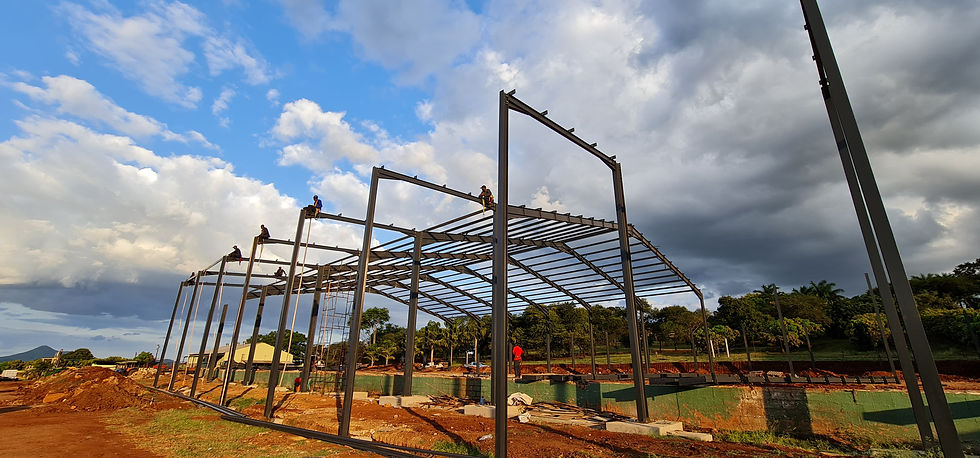The Pros and Cons of Pre-Engineered vs. Custom-Built Warehouses
- LTM Engineering

- May 18, 2023
- 4 min read
Updated: Jun 4, 2023
When it comes to building a warehouse, there are two main options: pre-engineered or custom-built. Each option has its own set of benefits and drawbacks, and it can be difficult to determine which is the best fit for your business. Pre-engineered warehouses are designed to be quickly and easily assembled, while custom-built warehouses are tailored to meet specific needs and requirements. The decision between the two ultimately comes down to factors such as budget, timeline, and desired functionality. In this article, we'll explore the pros and cons of both pre-engineered and custom-built warehouses, allowing you to make an informed decision on which option is right for you. Whether you're a small business owner or a seasoned professional, understanding the differences between these two types of warehouses is crucial in ensuring your business's success. So, let's dive in and explore the world of warehouse construction!

What is a pre-engineered warehouse?
A pre-engineered warehouse is a warehouse that is designed and manufactured in a factory before being shipped to the construction site. These warehouses are typically made of steel and are designed to be quickly and easily assembled. The components of the warehouse are pre-engineered to fit together, allowing for fast construction.
Benefits of pre-engineered warehouses
One of the biggest benefits of pre-engineered warehouses is speed of construction. Since the components are pre-engineered to fit together, the construction process is much faster than with a custom-built warehouse. This can be a huge advantage for businesses that need a warehouse quickly.
Pre-engineered warehouses are also cost-effective. Since the components are manufactured in a factory, there is less waste than with a custom-built warehouse. This can lead to cost savings for the business. Additionally, pre-engineered warehouses are often less expensive than custom-built warehouses.
Another benefit of pre-engineered warehouses is their durability. Since they are made of steel, they are resistant to fire, pests, and other hazards. This can help ensure that the warehouse lasts for many years.
Limitations of pre-engineered warehouses
One limitation of pre-engineered warehouses is their lack of customization. Since the components are pre-engineered, there is less flexibility in the design of the warehouse. This can be a disadvantage for businesses that have specific needs or requirements.
Another limitation of pre-engineered warehouses is their size. Since the components are manufactured in a factory, there are limitations on the size of the warehouse. This can be a disadvantage for businesses that need a large warehouse.
Pre-engineered warehouses also have limitations when it comes to insulation. Since they are made of steel, they can be difficult to insulate. This can lead to higher energy costs for the business.

What is a custom-built warehouse?
A custom-built warehouse is a warehouse that is designed and built specifically for a business's needs. These warehouses are typically built on-site and can be made of a variety of materials.
Advantages of custom-built warehouses
One of the biggest advantages of custom-built warehouses is their customization. Since they are built specifically for a business's needs, there is a high degree of flexibility in the design of the warehouse. This can be a huge advantage for businesses that have specific needs or requirements.
Custom-built warehouses are also often larger than pre-engineered warehouses. Since they are built on-site, there are fewer limitations on the size of the warehouse. This can be a huge advantage for businesses that need a large warehouse.
Another advantage of custom-built warehouses is their insulation. Since they are built on-site, there are more options for insulation. This can lead to lower energy costs for the business.
Disadvantages of custom-built warehouses
One disadvantage of custom-built warehouses is their cost. Since they are built specifically for a business's needs, they can be more expensive than pre-engineered warehouses. This can be a disadvantage for businesses that are on a tight budget.
Custom-built warehouses also take longer to construct than pre-engineered warehouses. Since they are built on-site, the construction process is slower. This can be a disadvantage for businesses that need a warehouse quickly.
Another disadvantage of custom-built warehouses is their durability. Since they are made of a variety of materials, they may not be as durable as pre-engineered warehouses. This can lead to higher maintenance costs for the business.

Pre-engineered vs. custom-built warehouses: Key differences
The key differences between pre-engineered and custom-built warehouses are speed of construction, customization, size, insulation, cost, and durability. Pre-engineered warehouses are faster to construct, less customizable, smaller, more difficult to insulate, less expensive, and more durable. Custom-built warehouses are slower to construct, more customizable, larger, easier to insulate, more expensive, and less durable.
Factors to consider when choosing between pre-engineered and custom-built warehouses
When choosing between pre-engineered and custom-built warehouses, there are several factors to consider. These include budget, timeline, desired functionality, size, insulation, and durability.
If budget is a concern, a pre-engineered warehouse may be the best option. If timeline is a concern, a pre-engineered warehouse may also be the best option. If customization is a concern, a custom-built warehouse may be the best option. If size, insulation, or durability are concerns, a custom-built warehouse may be the best option.

Conclusion: Which option is best for your business?
When it comes to building a warehouse, there are two main options: pre-engineered or custom-built. Each option has its own set of benefits and drawbacks, and the decision ultimately comes down to factors such as budget, timeline, and desired functionality. Pre-engineered warehouses are faster and less expensive, but less customizable and less durable. Custom-built warehouses are more customizable and more durable, but more expensive and slower to construct. By considering these factors, you can make an informed decision on which option is best for your business.



Comments